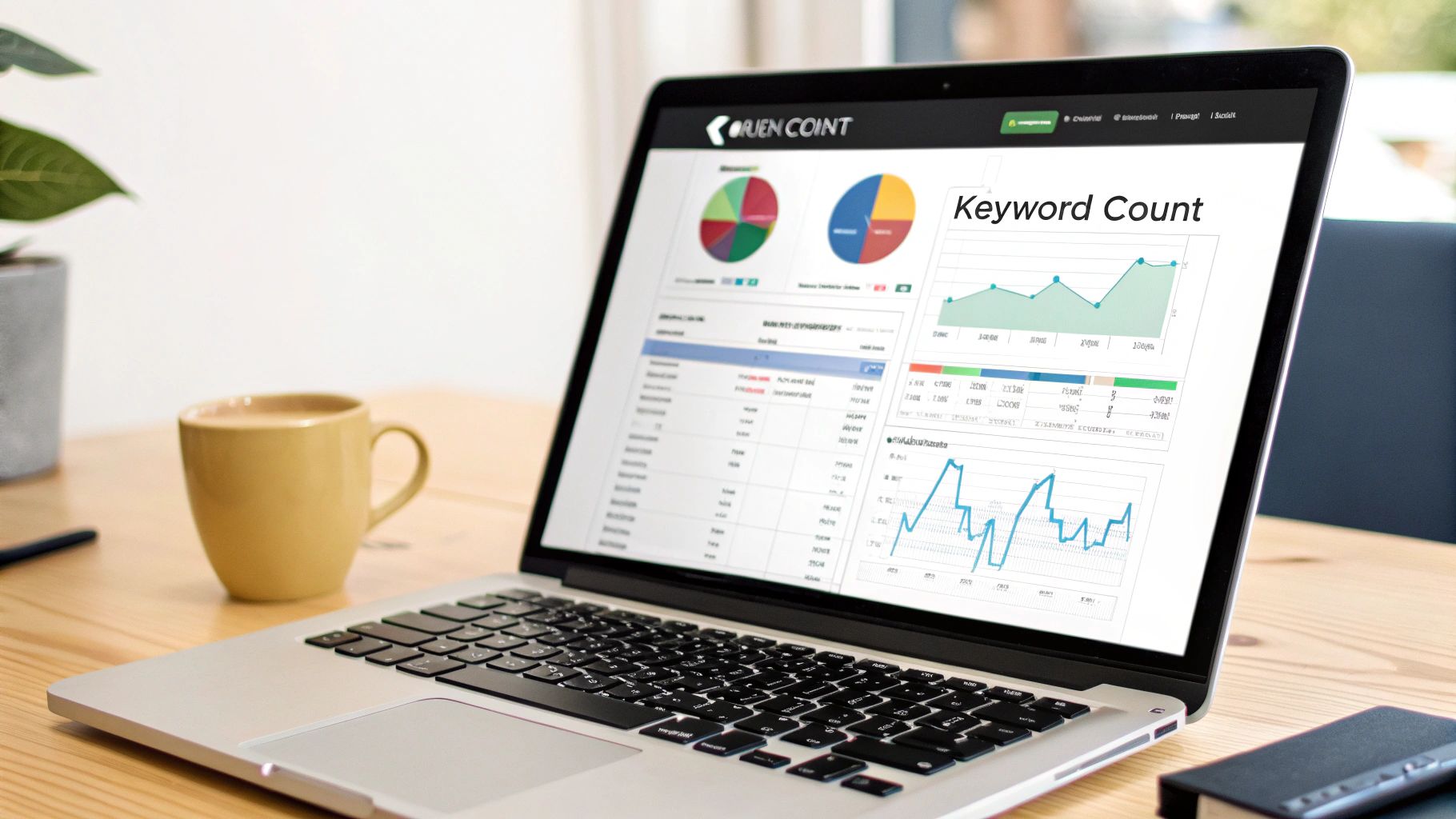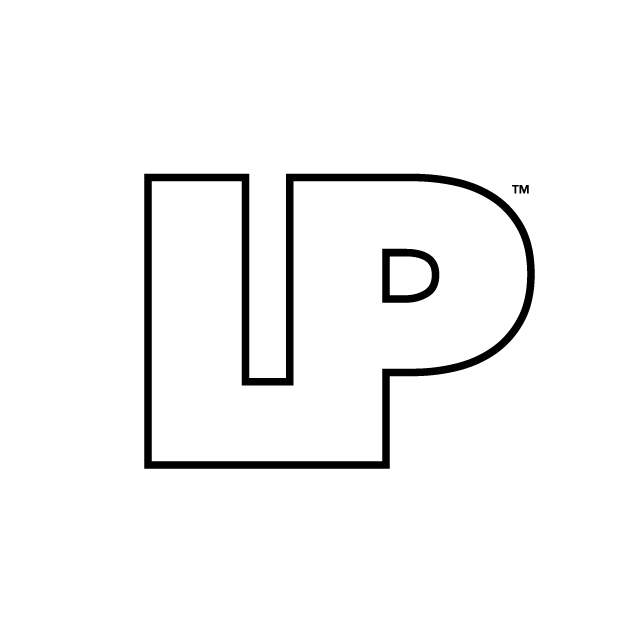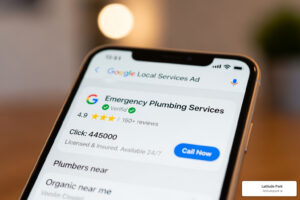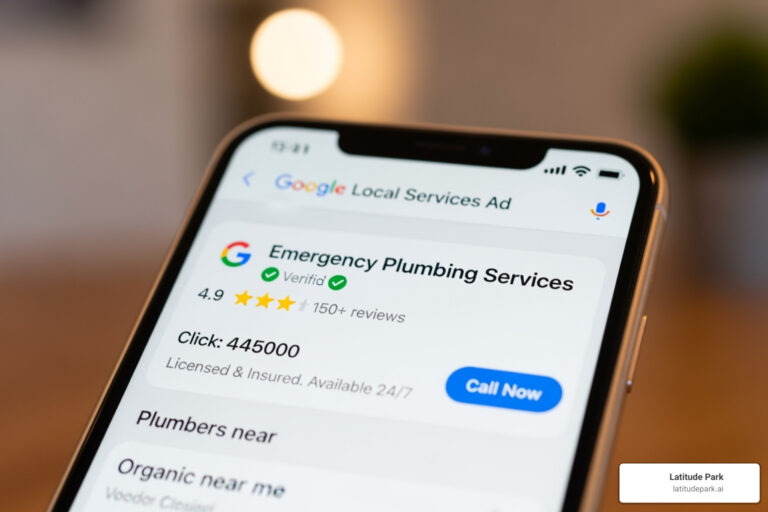When someone asks, "how many keywords should I use for SEO," the honest answer is, it depends. There’s no magic number. The real goal is strategy over sheer quantity—it’s all about using the right keywords in the right places, not just cramming as many as you can onto a page.
The Myth of the Magic Keyword Number
Thinking about keywords is a lot like gathering ingredients for a recipe. A simple dish might only need a few key components to shine. A more complex one? It requires a whole list to get the flavor just right. Your approach to keywords works the same way; it depends entirely on the page's purpose and the story you're trying to tell.
There's a common misconception that more keywords automatically lead to better rankings. That’s an outdated view that can actually hurt your performance today. Modern SEO rewards pages that are focused, relevant, and give the reader a fantastic experience.
The most effective SEO strategies don't ask, "How many keywords should I use?" Instead, they ask, "Which keywords truly matter for this page's specific goal?" This simple shift reframes your entire approach from a game of volume to one of strategic impact.
Context Is Everything
The number of keywords a page can effectively target varies wildly based on its job. For example, a homepage typically only needs about three to five main keywords. Its primary role is to introduce your brand and guide visitors, not cover every single topic under the sun.
On the other hand, a detailed blog post that dives deep into a subject and answers multiple related questions can successfully target 15 to 30 keywords and their variations. If you want to explore this distinction further, there's an excellent in-depth guide on keyword usage from seoprofy.com.
Here’s a quick breakdown of how this plays out in the real world:
- Homepage: Focuses on core brand terms and high-level service keywords. Practical example: a marketing agency might target "small business marketing agency," "franchise SEO services," and "digital marketing for local businesses." These keywords define who they are and what they do at a glance.
- Service Page: Gets more specific, targeting transactional terms related to a single offering. Practical example: the same agency's service page for Google Ads would target phrases like "Google Ads management for franchises," "PPC services for small business," and "hire a Google Ads expert."
- Blog Post: Uses one primary informational keyword and weaves in many related long-tail questions to cover a topic from every angle. Practical example: a blog post could target the primary keyword "how to get more leads with meta ads" and include secondary keywords like "common meta ad mistakes," "meta ads budget for beginners," and "best ad creatives for Facebook."
This table gives a handy at-a-glance view of how keyword strategy changes depending on the type of page you're working on.
Keyword Targeting by Page Type
| Page Type | Primary Keyword Focus | Recommended Keyword Count |
|---|---|---|
| Homepage | Broad, brand-defining terms | 3-5 |
| Service/Product Page | Specific, transactional keywords | 5-15 |
| Blog Post/Article | Informational, long-tail keywords | 15-30+ |
| Landing Page | Highly focused, campaign-specific terms | 1-5 |
As you can see, there's no single rule. The context of the page dictates the strategy.
Ultimately, the "right" number of keywords is whatever it takes to cover a topic thoroughly and naturally for your reader. If it feels forced, you’ve probably gone too far.
Focus on Relevance, Not Just Repetition

Let's get one thing straight: modern search engines are incredibly smart. The old days of tricking Google by cramming a keyword into your page over and over are long gone. In fact, trying that today—a practice called keyword stuffing—is a surefire way to get your page buried in the search results.
Instead, the real key to ranking well is building topical authority. Think of it like becoming a go-to specialist in a very specific field. A single page trying to cover "small business marketing," "franchise accounting," and "corporate team building" all at once will probably fail at ranking for any of them. It just sends mixed signals to search engines.
A much smarter approach is to give each page a single, clear purpose. This focus is what allows you to dive deep into a subject, answer a user's questions thoroughly, and establish your site as a credible, trustworthy resource.
The Power of Topical Focus
When you create a page with a sharp, singular focus, you naturally end up using your main keyword alongside its semantic variations. These are simply the related terms and concepts that give your content context. For example, a page about "how many keywords for SEO" will organically include phrases like "keyword density," "long-tail keywords," and "user intent."
This creates a rich, contextually relevant piece of content that both your readers and search engines will love. It proves that your page is a comprehensive resource, not just a thin article trying to game the system.
Practical Insight: Think of topical focus as creating a "hub and spoke" model with your content. A broad "hub" page (e.g., "Digital Marketing Guide") can introduce a topic, then link out to highly specific "spoke" pages (e.g., "SEO for Beginners," "Email Marketing Basics," "Social Media Strategy"). Each "spoke" page has a laser focus on one keyword group, strengthening the authority of the entire topic cluster.
This strategy pays dividends in your search rankings. As a general rule of thumb, it's best to target around one to four SEO keywords per page to maintain this laser focus. For most web pages, this is the sweet spot for signaling your topic clearly without watering down its relevance. You can dig deeper into this concept with these keyword best practices from writesonic.com.
By prioritizing relevance over sheer repetition, you create content that search engines trust and—more importantly—that provides genuine value to your audience.
Where to Place Keywords for Maximum Impact

Knowing how many keywords to target is a great start, but the real magic happens when you know exactly where to put them. Think of your webpage like prime real estate; some spots are just more valuable than others. Placing keywords in these high-impact areas sends powerful signals to search engines, telling them precisely what your content is about.
Your primary goal is to weave keywords in naturally, so the writing stays smooth and helpful for the people reading it. If you try to force them in where they don’t fit, your content will sound clunky and robotic—a huge turn-off for both visitors and Google. The best approach is to place your main keyword and its variations strategically across key on-page elements.
A Practical Keyword Placement Checklist
Here are the most critical spots to place your keywords for the biggest SEO boost. Getting this right is a cornerstone of creating SEO-friendly content that actually ranks.
- Title Tag: This is arguably the most important place. Try to get your primary keyword as close to the beginning of the title as you can. For example:
How Many Keywords for SEO: A Practical Guideis better thanA Practical Guide to Using Keywords for SEO. - Meta Description: While it's not a direct ranking factor, a compelling meta description with your keyword will get more people to click on your link in the search results. A good example: "Wondering how many keywords for SEO to use? Discover the right number for your pages and learn where to place them for maximum impact."
- H1 Heading: Your main page title (the H1) should contain your primary keyword. Remember, only one H1 per page!
- H2/H3 Subheadings: Sprinkling your primary keyword or close variations into some of your subheadings helps reinforce the page's topic for both readers and search engines.
- Introduction: Mention your main keyword within the first 100-150 words. This immediately confirms the page's subject and tells visitors they're in the right place.
- URL: Keep your URL short, sweet, and descriptive. Make sure it includes your primary keyword, like
/how-many-keywords-for-seoinstead of something generic like/p?id=123. - Image Alt Text: Alt text is essential for accessibility. Describe your images accurately for visually impaired users and include a relevant keyword where it makes sense. For an image of a checklist, the alt text could be
alt="Checklist for where to place SEO keywords on a page."
Pro Tip: Don't obsess over cramming your exact keyword into every single one of these spots. Use synonyms and related phrases to keep the language sounding natural. Google is smarter than ever—it understands context and rewards content written for humans, not robots.
Choosing Your Keywords: Head vs. Long-Tail

When you're figuring out which keywords to target, it's crucial to know that not all keywords are created equal. The real game-changer is understanding the difference between broad head terms and hyper-specific long-tail keywords. This one concept is fundamental to building an SEO strategy that doesn’t just get you traffic, but gets you the right traffic.
Head terms are the big, flashy, one-word keywords like "marketing" or "SEO." They get a ton of search volume, which sounds great on paper. The problem? They're insanely competitive, and the people searching for them have all sorts of different intentions. It's tough to rank and even tougher to turn that vague interest into actual customers.
Long-tail keywords are the complete opposite. These are the longer, more detailed phrases people actually type into Google when they know what they want. Think "content marketing strategy for small business." Far fewer people are searching for that exact phrase, but the ones who are have a specific problem they need to solve. They’re much closer to making a decision.
The Power of Long-Tail Keywords
If there's one piece of advice I give over and over, it's to build your content strategy around long-tail keywords. It’s one of the smartest moves you can make in SEO.
Because they're so specific, the competition is way lower, and the traffic they bring in is highly qualified. Someone searching for "best coffee beans" is just browsing. But the person searching for "buy single-origin Ethiopian coffee beans online"? They’ve got their credit card out, ready to go.
Practical Insight: A balanced keyword portfolio is key. Use broad head terms for top-level pages to build general visibility, but build your content strategy around specific long-tail keywords that capture high-intent users and drive conversions. For example, your homepage might target the head term "financial advisor," while a blog post targets the long-tail keyword "how to save for retirement in your 30s."
The data backs this up completely. A mind-boggling 94-95% of all keywords get 10 or fewer searches per month. That just goes to show how much of the search world is dominated by these specific, long-tail queries. And it’s not just tiny keywords; nearly 29% of keywords with over 10,000 monthly searches are three or more words long, proving their growing importance.
Ultimately, a winning strategy doesn't choose one over the other—it blends them. You need a mix of head terms for broad awareness and long-tail phrases to capture ready-to-act users. To get a handle on finding this perfect mix, you should check out these 10 keyword research tips that will help rank your website.
Putting a Real-World Keyword Strategy into Action
Enough with the theory—let's roll up our sleeves and build a keyword strategy from scratch. We'll use a real-world example so you can see how this works in practice. This is the exact kind of blueprint you can use over and over again to figure out how many keywords a page needs and where to put them.
Imagine you're writing a blog post called "A Beginner's Guide to Drip Coffee."
First things first, you need a primary keyword. This is the main search query you want your page to rank for. After a bit of digging, you settle on "drip coffee for beginners". Why? Because it perfectly nails what your ideal reader is looking for. This keyword becomes the North Star for your entire article.
Next up are your supporting keywords, sometimes called LSI keywords. These are related terms that add depth and context, showing Google you’ve covered the topic from all angles. For our coffee guide, these might include:
- "how to use a drip coffee maker"
- "best coffee beans for drip"
- "drip coffee water temperature"
- "coffee to water ratio for drip"
These aren’t just random phrases. They represent the real questions a beginner would have. By weaving them into your content, you create a genuinely helpful resource that leaves no stone unturned, which is a huge signal of topical authority for search engines.
Mapping Keywords to Your Content
Now comes the fun part: strategically placing these keywords throughout your article. Your primary keyword gets the VIP treatment in high-impact spots, while your supporting keywords help build out the sub-sections and add valuable detail. To find the best terms, using comprehensive SEO tools like Semrush is a game-changer, giving you the data you need to make smart choices.
The real key is finding that perfect balance between search volume, competition, and how well the keyword matches what your audience actually needs.

This visual really brings it home. The ideal keyword sits right in that sweet spot where what your audience cares about overlaps with decent search volume and competition you can actually beat.
To make this crystal clear, here’s a quick keyword map showing how you might structure that "Drip Coffee for Beginners" blog post.
| Page Element | Keyword Placement Example |
|---|---|
| SEO Title | The Ultimate Guide to Drip Coffee for Beginners |
| H1 (Main Headline) | A Beginner’s Guide to Making Perfect Drip Coffee |
| Introduction | Welcome to our guide on drip coffee for beginners! |
| H2 (Subheading) | How to Use a Drip Coffee Maker Step-by-Step |
| H2 (Subheading) | The Best Coffee Beans for Drip |
| H2 (Subheading) | Finding the Right Drip Coffee Water Temperature |
| H2 (Subheading) | Getting the Perfect Coffee to Water Ratio for Drip |
| Conclusion | Now you’re ready to master the art of drip coffee! |
This table shows how a simple plan ensures every keyword has a specific job to do, creating a well-organized and easy-to-read article for both users and search engines.
This structured approach is absolutely essential if you want to grow your business with SEO in a predictable way. By mapping out your keywords before you start writing, you guarantee that every sentence you craft is serving a strategic purpose.
Frequently Asked Questions About Keyword Strategy
Even with a solid plan in hand, a few lingering questions always seem to pop up. Let's tackle some of the most common ones I hear from clients, so you can move forward with total confidence in your keyword strategy.
What Is Keyword Density and Does It Still Matter?
Keyword density is an old-school SEO metric that measures how many times a keyword appears on a page as a percentage. Back in the day, it was a pretty big deal, but honestly, this concept is now outdated.
Today's search engines are far more sophisticated. They're built to understand natural language and the overall topic of a page. Chasing some arbitrary percentage is a waste of energy and can make your writing sound robotic.
Practical Insight: Instead of tracking keyword density, run a "find and replace" check before you publish. Search for your main keyword. If it appears an unnatural number of times or in awkward places, swap it out with a synonym or simply rephrase the sentence. For example, instead of saying "our SEO services help with SEO," try "our SEO services help improve your search ranking." Your goal is readability, not repetition.
How Many LSI Keywords Should I Use on a Page?
There's no magic number for LSI (Latent Semantic Indexing) keywords. It's better to think of them as part of a natural conversation, not items to check off a list. These are simply the related terms and phrases that give your topic real depth.
For instance, if you're writing about "drip coffee," you’re almost certain to mention things like "water temperature," "grind size," and "paper filters." The goal isn't to hit a quota; it's to create a complete, go-to resource that answers all of a reader's potential questions.
- When you write a comprehensive piece, LSI keywords will show up on their own.
- They signal your expertise and help you build topical authority.
- Don't ever force them in. Let them flow naturally with your writing.
The best test is to ask yourself: "Does this page fully cover the topic from every important angle?" If the answer is a confident yes, you've probably used the right amount of related terms without even trying.
Should My Keyword Strategy Be Different for a Product Page vs a Blog Post?
Absolutely. The user's mindset—their intent—is completely different for these two page types, so your keyword approach has to adapt accordingly.
A product page is all about targeting transactional keywords. Your focus should be laser-tight, zeroing in on the product name itself and the phrases people use when they have their wallets out.
- Practical Example: A product page for a specific running shoe should target "buy Brooks Ghost 15 online," "Brooks Ghost 15 men's size 11," and "best price on Brooks Ghost 15."
- Focus: A smaller set of keywords, mostly the product name and its key features.
- Goal: Drive an immediate purchase.
A blog post, on the other hand, targets informational keywords. It’s designed to attract people much earlier in the buying cycle, when they’re still researching options or trying to solve a problem.
- Practical Example: A blog post on the same company's site might target "how to choose the best headphones for running," "are over-ear or in-ear headphones better for exercise," and "running headphones that don't fall out."
- Focus: A wider variety of long-tail keywords and related questions.
- Goal: Educate the reader, build trust, and gently guide them toward a solution (like the product page).
By tailoring your strategy like this, you meet people exactly where they are in their journey, which makes your content infinitely more effective.
Ready to stop guessing and start ranking? At Latitude Park, we build data-driven SEO strategies for franchises and small businesses that deliver real results. Let us handle the keyword research, content creation, and technical optimization so you can focus on what you do best. Learn more about our SEO services.









